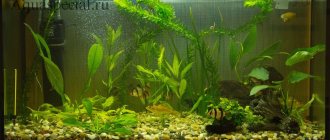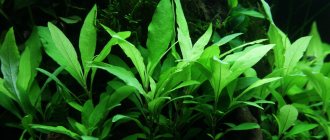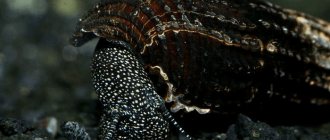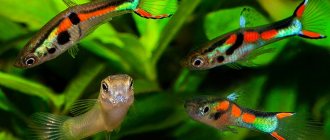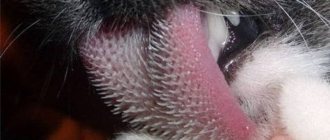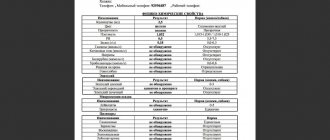Types, colors and sizes
The plant is a small bush, the number of leaves on which varies from 5 to 15. The shape of the leaves can be lanceolate or ovoid in various variations. Plants that sit in streams for a long time have elongated leaves with an uneven surface. The color range of leaf blades is varied - from green and brown to olive and deep red. The specific option depends on the light level of the place where cryptocoryne grew.
Cryptocoryne in an aquarium
The inflorescence is small and has an unusual, very interesting structure. It is a long narrow tube, slightly widened at the bottom. Inside it is a cob up to 3 cm in length. The inflorescence is waterproof. The root system of Cryptocoryne is horizontal.
Cryptocoryne became widespread as an aquarium plant in the 1930s. More than 80 species of flower are known in the world, half of which are suitable for keeping in an aquarium. The difference between the species lies in the characteristics of the shape and color of the leaves of each of them. According to the first criterion, all plants can be divided into three groups: with rounded, elongated and lanceolate leaf blades.
Cryptocoryne Wendta brown
Particularly popular among aquarists are Cryptocoryne Wendta green, which is distinguished by its elongated leaves of olive or dark green color, as well as Cryptocoryne Wendta brown with even more elongated brown leaves.
The second variety of Vendta is excellent for beginner aquarists. This is perhaps one of the most unpretentious and least susceptible to rotting cryptocorynes. The reddish tint of its leaves serves as a bright accent in the color scheme of the aquarium flora.
Cryptocoryne Wendta brown
Cryptocoryne Wendta green
This plant is found quite often in amateur collections. This is due, first of all, to its bright appearance, small size and quick adaptation to a new environment. In natural conditions it is found on the island of Sri Lanka. In the Wendtu culture, green is planted in the foreground of the aquarium, thereby creating dense, picturesque thickets of varying heights - from 10 to 30 cm.
Features of the appearance of the plant are formed depending on the conditions of detention. The optimal characteristics of water are the following: temperature should be 24-28 oC, acidity pH - from 6.5 to 7.5, hardness dHG - from 4 to 10. Lighting should be moderate, the soil should be soft, saturated with humus, 5-7 cm thick .
The plant feels comfortable in both old and recently added water. This species can be grown in aquariums of any size. It is important to remember that in a small vessel Wendta will not grow to the natural size characteristic of its natural habitat.
Cryptocoryne Wendta green
Cryptocoryne Willis
This species is often confused with Cryptocoryne nevillii, which is never actually used in the aquarium hobby. The height of Cryptocoryne Willis ranges from 7 to 20 cm, and the diameter of the rosette is from 7 to 15 cm. After planting, like most other varieties, this plant requires a month's adaptation, after which Cryptocoryne begins to produce many new shoots, forming dense thickets.
Cryptocoryne Willis thrives in warm (24-28°C), soft, acidic water in low or bright diffused light. The plant is especially comfortable in a shady space. He gets used to new conditions quite quickly.
The plant is planted in thin soil filled with nutrients. If there are not enough of them, the growth of cryptocoryne is greatly reduced.
The result of the reproduction of this species is the massive growth of the flower in the aquarium, which makes the vessel look more beautiful, and the local fauna finds an excellent place for playing hide and seek. Cryptocoryne Willis often forms bizarre biological forms, for example, dwarf, which is excellent for growing in water gardens.
Cryptocoryne Willis
Cryptocoryne aponoghetonolifolia
In the natural environment, this species is found in bodies of water with running water. In an aquarium, the size of the flower does not exceed 40-50 cm in height. It takes about four weeks for one new leaf to appear. With quality care, the plant will delight its owners with flowering in the form of small lilac buds.
The main difficulty in breeding this variety of cryptocoryne is the need to maintain soil and water temperatures at the same level. It is very important to monitor water hardness and acidity levels, since the flower reacts to their changes by dropping leaves.
Cryptocoryne aponoghetonolifolia
Conditions in the aquarium
All the huge number of species and forms of cryptocorynes grows in the countries of Southeast Asia, on the island. Sri Lanka, in Malaysia. These are tropical plants for which only warm water (+22...+28°C) is suitable . The optimal temperature for maintenance is approximately +25°C, but with an increase it is possible to cause plants to bloom.
Cryptocorynes prefer not too intense lighting (for most species, 0.5 W per 1 liter of aquarium volume is enough), but they should not be excessively shaded. With a lack of light, the bushes lose their compactness and stretch out. In red-leaved forms, the color changes towards green shades. Depending on the type, illumination of 0.7-1 W/l is considered optimal.
A peculiarity of all types of cryptocorynes is susceptibility to rotting and dissolution of leaves (cryptocoryne disease). The effect occurs due to a change in environmental conditions, and the disease often affects young rosettes transplanted into another container. The bush may begin to disappear in winter due to temperature changes or lack of light, changes in the composition of water that cannot be detected in time.
For salvation, it is better not to arrange transplants and transfer to new conditions. After removing the remaining foliage, the rhizome of the plant should be left in its usual place, without removing it from the ground. When water parameters stabilize, the rhizome will again produce a rosette of leaves. When purchasing new plants, it is best to purchase them from local breeders who use water with similar characteristics for growing.
Care and maintenance
The soil should be saturated with nutrients, and its average thickness should be approximately 5 cm. In order for the growth of cryptocoryne to occur evenly and not slow down, the temperature indicators of the water and soil must match. It is recommended to transplant a plant from one aquarium to another no more than once a year, since the flower takes a long time to adapt to new conditions.
The lighting should not be too bright; the ideal option is dim or more intense, but diffused light. The optimal water temperature is in the range of 24-28°C, the recommended acidity level is from 6.5 to 7.4, and the hardness should be medium. Every week, a quarter of the water volume should be renewed.
Flowering of cryptocoryne, the upper part of which is not immersed in water, occurs in almost the same way as in ordinary land plants. Flowers of other varieties, which are completely in the water, are spread on its surface. To flower in an aquarium, the plant must provide the following conditions:
- It is very important to pay special attention to the quality and nature of the soil. It is advisable that the soil be silted. If the aquarium is being started for the first time, peat fertilizer should be added to it, which also includes silt and clay. The substrate should consist of coarse river sand and small pebbles. The recommended soil depth is 4-5 cm. During intensive development, the flower should be fed with mineral fertilizers up to 3-4 times a month.
- Further, for normal growth of cryptocoryne, it is necessary to provide sufficient lighting daily for 12 hours. Optimal lighting conditions are considered to be those in which the power of fluorescent lamps is 0.3 W per 1 liter of water. For better growth of Cryptocoryne, before planting, it is recommended to trim the roots of the plant by about 2/3 of their original length (with at least 3-4 cm remaining, so that it is enough to hold the flower in the ground).
Cryptocoryne
The absorption of beneficial elements by the plant occurs through the root system. The soil for them is a nutrient medium, so the owner must ensure its maximum quality. If the substrate is silted, then there will be no need for frequent feeding. It is enough to add iron-containing substances to the soil just once a year in order to bring the amount of this element closer to natural for Cryptocoryne.
By regulating the level of water heating, you can control the growth rate of the flower - the warmer the water, the more intensively cryptocoryne will develop. Indicators of hardness and acidity should always be at the same level or change gradually without sudden jumps. Otherwise, the leaves of cryptocoryne will begin to collapse.
It is not recommended to replant the plant, as it reacts negatively to changes in environmental conditions.
Cryptocorynes with long lanceolate leaves
Cryptocoryne aponogetifolia
Cryptocoryne aponogetonifolia - as the name suggests, its leaves are similar to aponogeton. Just like Aponogeton, this Cryptocoryne has a tuberous leaf blade and the leaf itself is just as long. This is a giant from the genus Cryptocoryne. Its oblong leaves can reach a height of more than a meter, especially in hard water.
Cryptocoryne crispatula var. balansae
Cryptocoryne balance is similar in appearance to the previous species. More correct name: Cryptocoryne curly balance
.
Cryptocoryne curly has a number of variations, among which the balance
is the easiest to maintain.
Therefore, over time, in the plant aquarium market, the name Cryptocoryne crispatula var
replaced the original
Cryptocoryne crispatula var.
balansae . This variation has a leaf 1-4 cm wide with a bubble plate. Lanceolate leaf 10-50cm long. Like many other Cryptocoryne species, Balance can be either green or brown.
Cryptocoryne retrospiralis
Cryptocoryne reverse spiral
(Cryptocoryne retrospiralis, Cryptocoryne retrospiralis)
. It differs from previous long-leaved species of cryptocorynes in having a narrower leaf - 0.1-1.5 cm and less pronounced tuberosity of the leaf blade. This cryptocoryne is often used when decorating aquariums by Takashi Amano.
Cryptocoryne planting rules
When planting in the ground, you must follow a few simple rules:
- This event should be held in the spring season.
- After removing the flower from the container , it must be cleared of algae and treated with cryptocoryne in a solution of potassium permanganate.
- The roots of the plant should be oriented strictly downwards, so a hole is made in the soil. A flower bush is placed in it so that the rhizome is completely below ground level. Then the sprout is carefully pulled up until the neck of the rhizome is flush with the soil surface.
- When planting several bushes, there should be a small gap between them (at least 15 cm).
Complete absence of leaf blade tuberosity and red variations
Cryptocoryne parva
Cryptocoryne parva is the smallest Cryptocoryne known. The size of its leaves is usually no more than 5 cm. The leaves are exclusively green. The Cryptocoryne parva mat looks very similar to the lileopsis mat and it would seem that this Cryptocoryne parva is a very good option for the foreground of an aquarium design. However, Cryptocoryne parva has a major drawback. It has a very low growth rate. Cryptocoryne parva grows much more slowly than even Lileopsis, which is known for its low growth rate. Therefore, this aquarium plant is poorly distributed and is extremely rarely used in aquascaping.
Cryptocoryne x willisii, Cryptocoryne lucens)
A hybrid of Cryptocoryne parva with various names: Cryptocoryne brilliantis , Cryptocoryne Willis or Willis , Cryptocoryne lucens . All this is one plant, which, like Cryptocoryne parva, stands apart among the popular Cryptocoryne plants in the aquarium hobby. Externally, Cryptocoryne parva is an enlarged copy of Cryptocoryne parva, but it grows much faster. The color of the leaves is also exclusively green. The leaf blade is smooth, without any tubercles. The leaf is elongated (up to 15cm) and thin (0.5-2cm). An excellent plant for the middle ground, the bushes of which do not grow very tall over time. A less common species of aquarium plant that has great potential for aquascaping.
If you have questions about this plant, ask them on the aquarium plant forum.
Possible plant diseases
Cryptocorynes are susceptible to a disease called cryptocoryne disease. It usually occurs in winter and is accompanied by softening and subsequent decomposition of the leaf plates. Pathology manifests itself as a result of changes in maintenance conditions, in particular, renewal of water in the aquarium, increasing or decreasing lighting, changing the filtration system, deteriorating soil and water quality, etc.
It also happens that the disease enters the aquarium with other plants. The disease is treatable. To do this, the cryptocoryne rhizome should be placed in clean water with purified soil.
